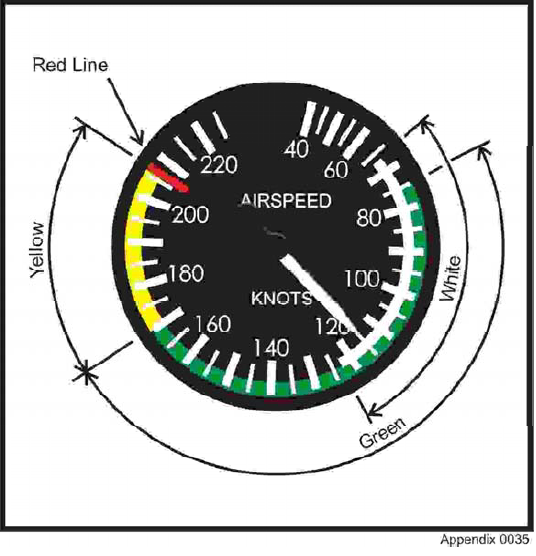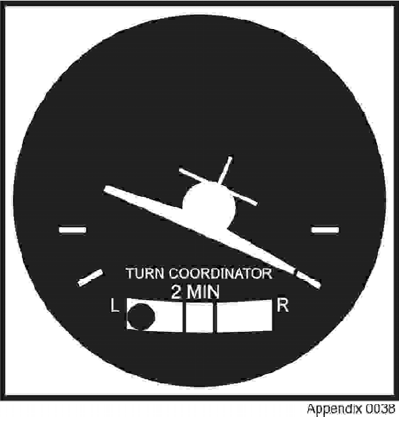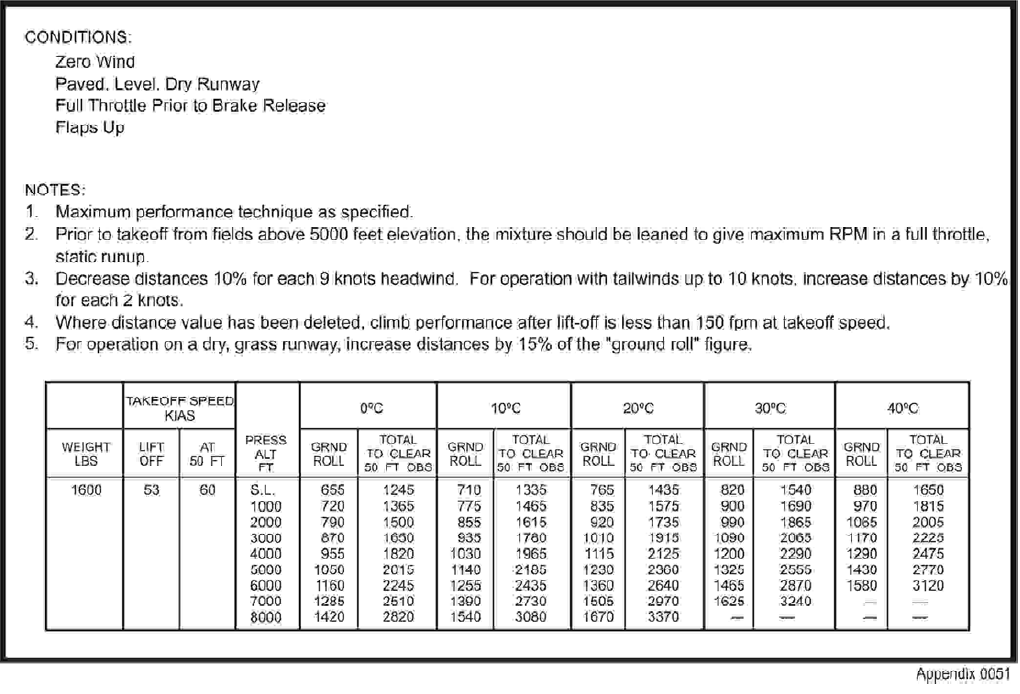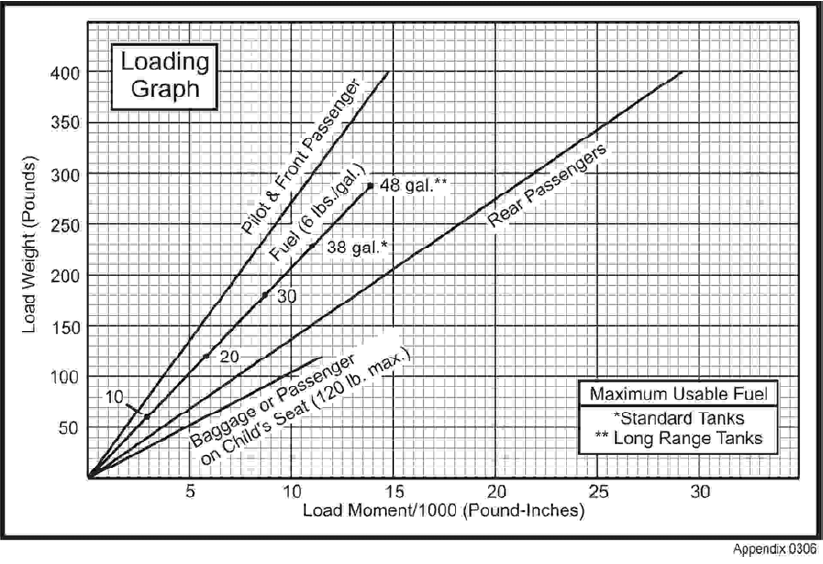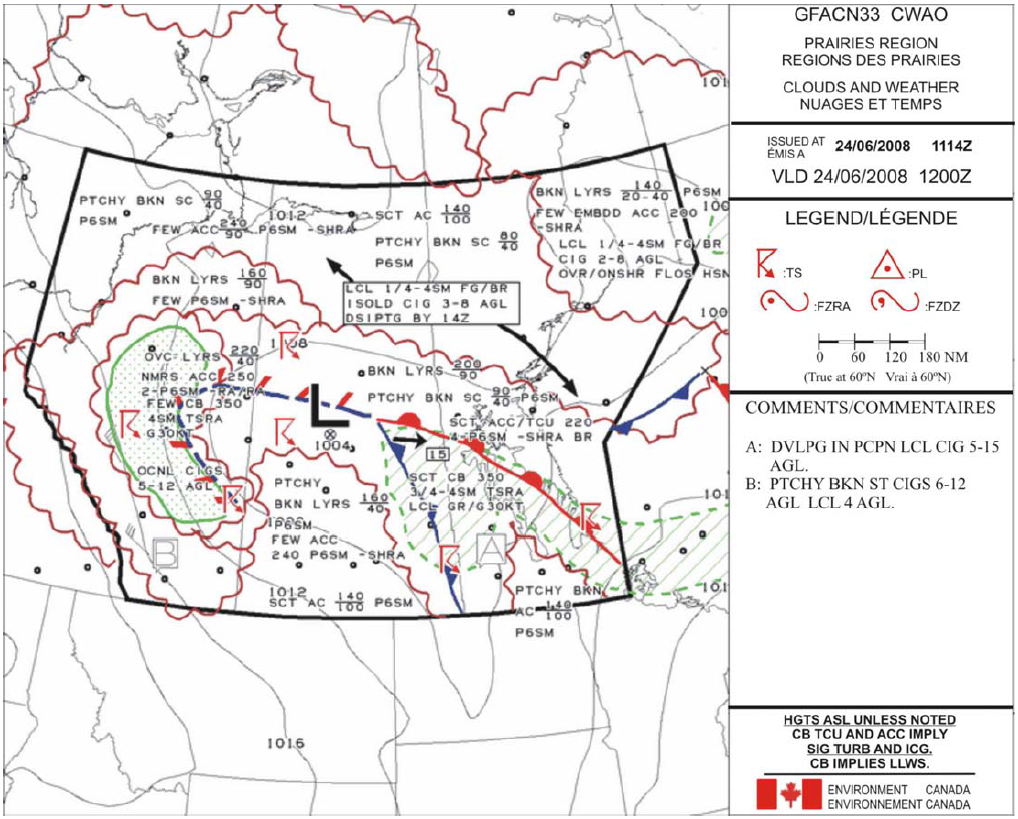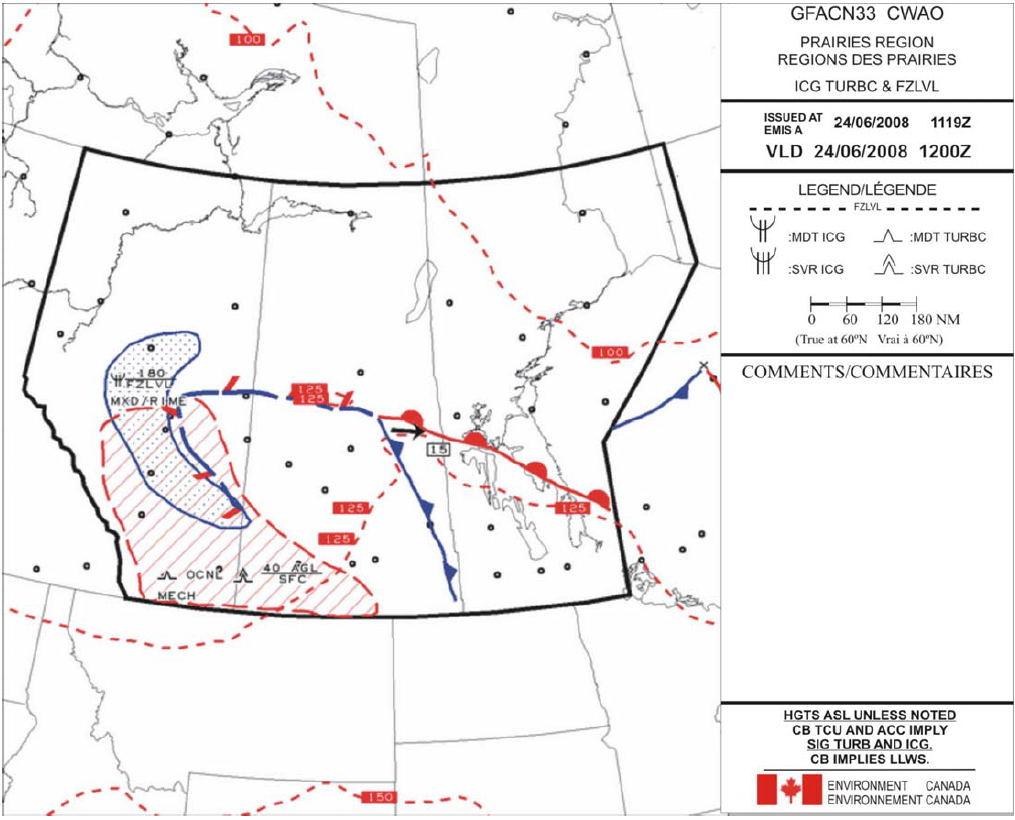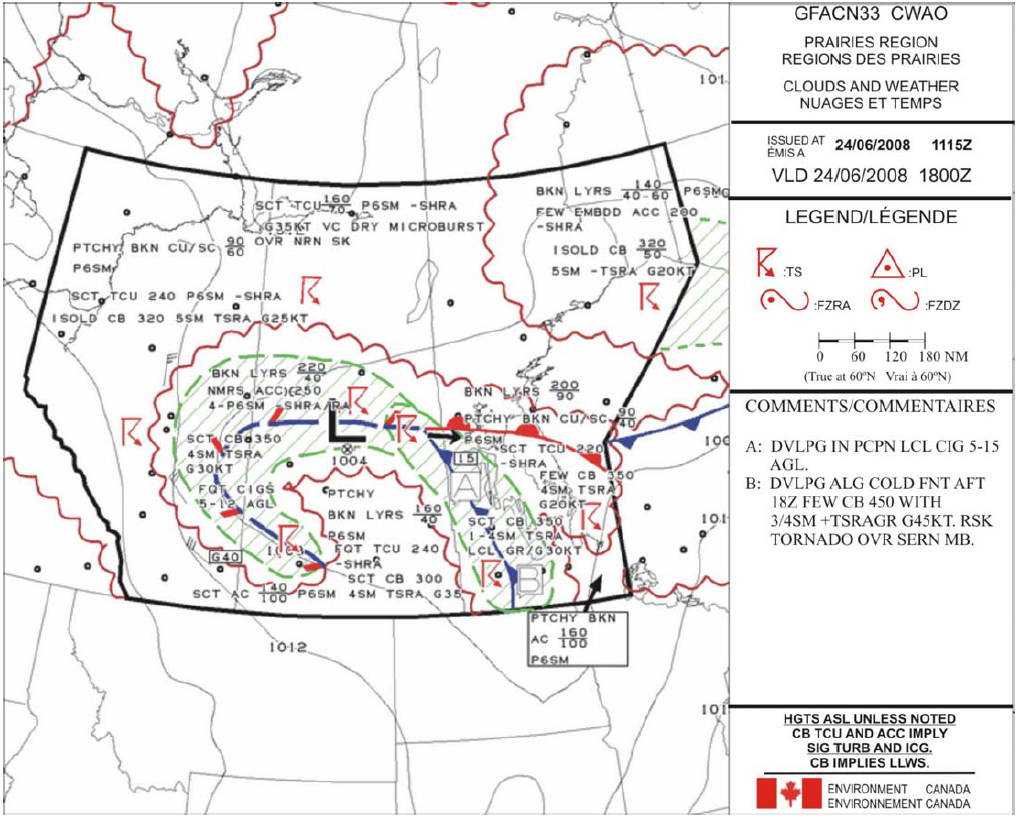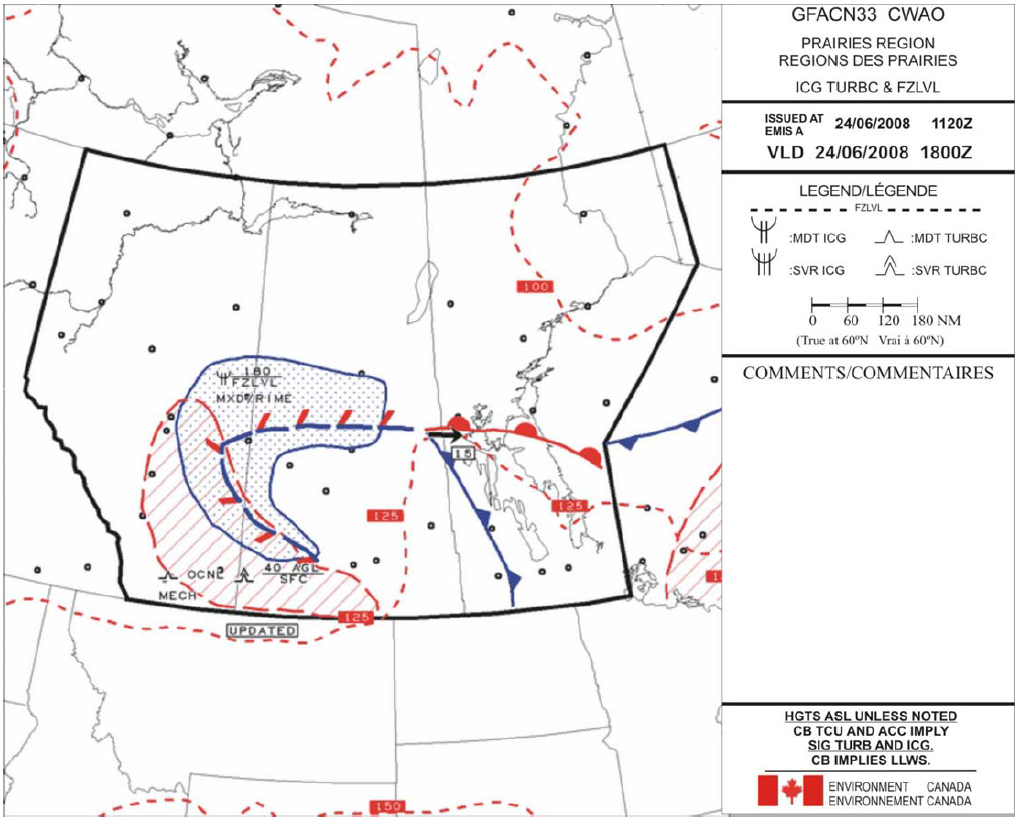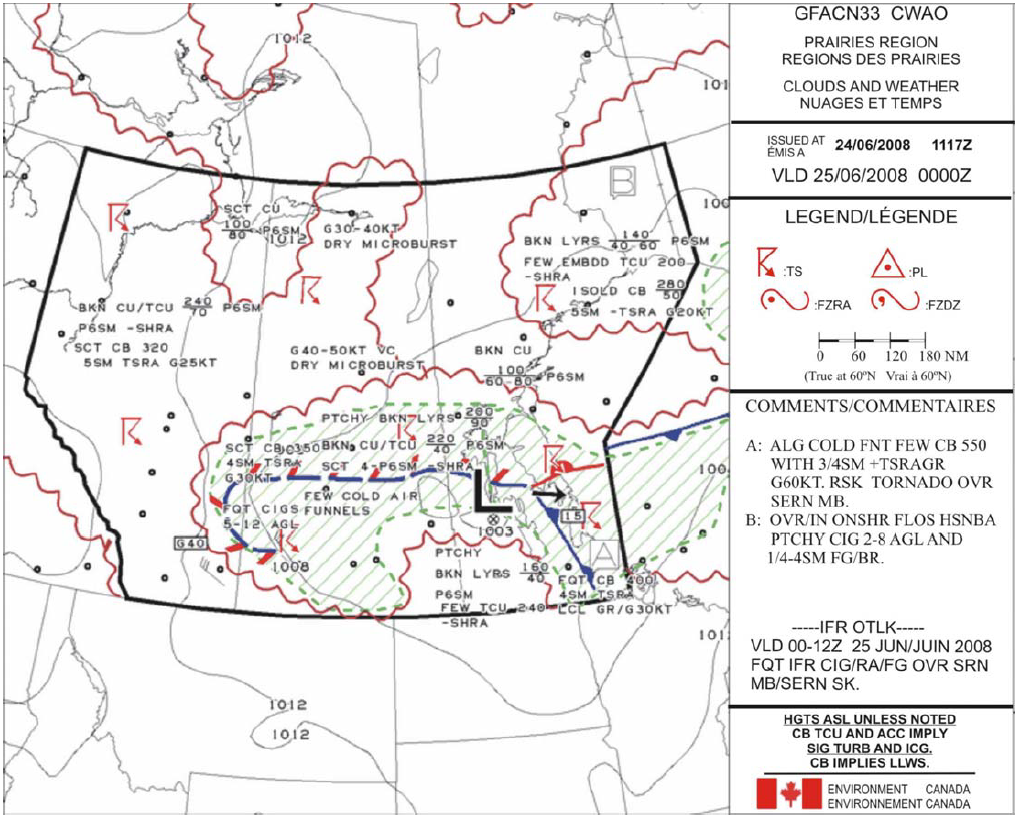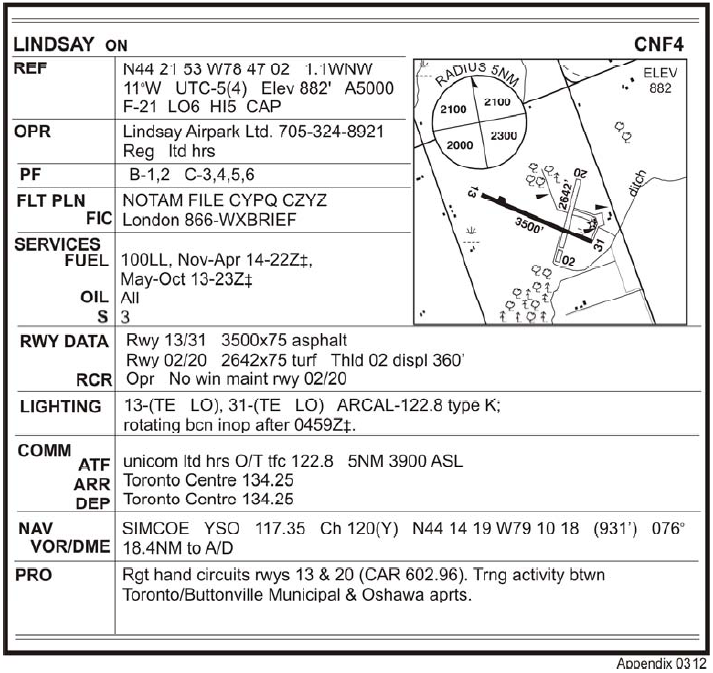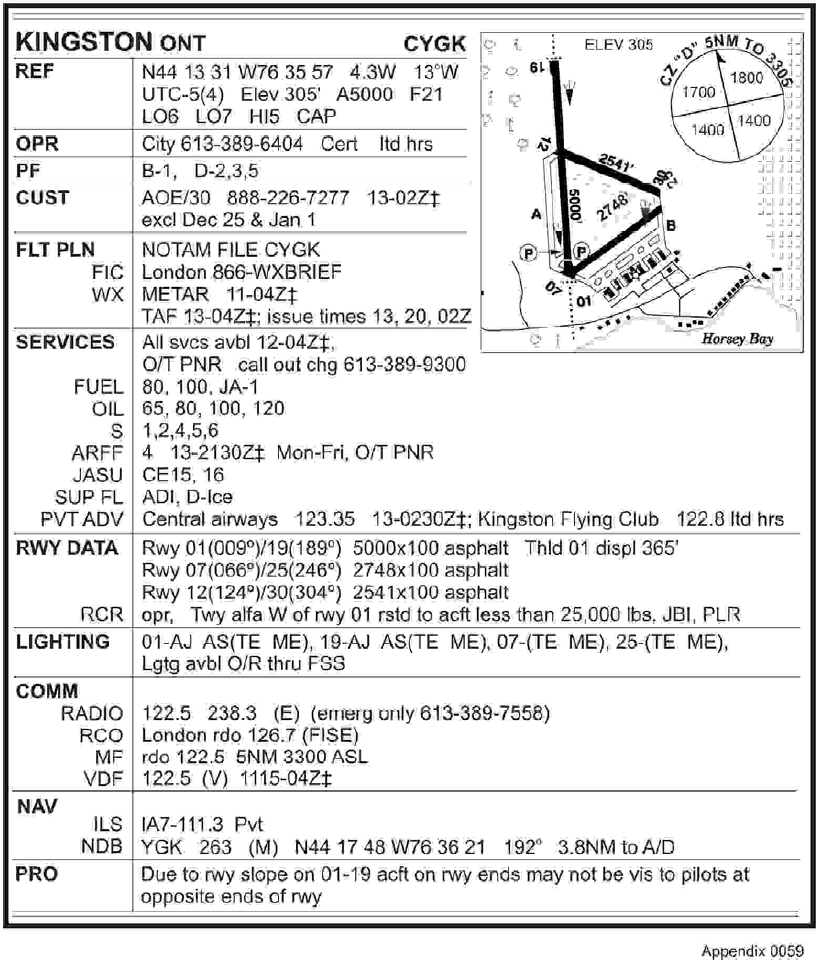Fourth Edition
November 2008
Copyright
© Her Majesty the Queen in Right of Canada, represented by the Minister of Transport, 2005
Cette publication est aussi disponible en français sous le titre Spéciment d'examen - Permis de pilote - Avion Ultra-léger.
For a print copy or an accessible version of this publication, please visit http://transact-en.tc.gc.ca or contact Transport Canada’s Publications Order Desk at 1-888-830-4911 — International at 613-991-4071.
An electronic version of this publication is available at https://tc.canada.ca/en/aviation/publications/civil-aviation-sample-examination-recreational-pilot-permit-private-pilot-licence-aeroplane-tp-13014
TP 13014E
(05/2009)
TC-1003184
Catalogue No. T52-4/32-2-2009E
ISBN 978-1-100-12738-5
Permission to reproduce
Transport Canada grants permission to copy and/or reproduce the contents of this publication for personal and public non-commercial use. Users must reproduce the materials accurately, identify Transport Canada as the source and not present theirs as an official version, or as having been produced with the help or the endorsement of Transport Canada.
To request permission to reproduce materials from this publication for commercial purposes, contact:
Publishing and Depository Services
Public Works and Government Services Canada
Ottawa ON K1A 0S5
droitdauteur.copyright@tpsgc-pwgsc.gc.ca
Table of contents
- Foreword
- Abbreviations
- Air Law
- Aeronautics - General Knowledge
- Meteorology
- Navigation
- Appendix and Answer Key
Foreword
This sample examination has been developed by Transport Canada to assist candidates in preparing for the Recreational Pilot Permit or Private Pilot Licence written examinations.
The questions contained in the sample paper are selected to indicate the form and type of questions that may be encountered.
The Recreational Pilot Permit examination consisting of 80 questions and the Private Pilot Licence examination consisting of 100 questions are set out in much the same proportion and order as in this sample paper.
Candidates are referred to the Study and Reference Guide titled Recreational Pilot Permit – Aeroplane (TP 12467E) or, Private Pilot Licence, including Helicopter to Aeroplane Pilot Licence – Aeroplane (TP 12880E) which specifies the subject areas from which questions may be set.
Abbreviations
Note: The abbreviations and acronyms listed below may be used throughout this guide.
- ADF
- automatic direction finding
- AGL
- above ground level
- AME
- aircraft maintenance engineer
- ASL
- above sea level
- ATC
- Air Traffic Control
- ATS
- Air Traffic Services
- C
- Celsius
- CARs
- Canadian Aviation Regulations
- CAS
- calibrated airspeed
- CDI
- course deviation indicator
- C of A
- Certificate of Airworthiness
- DF
- direction finding
- ELT
- emergency locator transmitter
- ETA
- estimated time of arrival
- GFA
- graphical area forecast
- gph
- gallons per hour
- IAS
- indicated airspeed
- IFR
- instrument flight rules
- in. Hg
- inches of mercury
- kHz
- kilohertz
- kt.
- knot(s)
- lb.
- pound(s)
- M
- magnetic
- mb
- millibar(s)
- METAR
- aviation routine weather report
- MHz
- megahertz
- NM
- nautical mile(s)
- OAT
- outside air temperature
- OBS
- omnibearing selector
- SM
- statute mile(s)
- SVFR
- special VFR flight
- TAF
- terminal aerodrome forecast
- TAS
- true airspeed
- TCA
- terminal control area
- UTC
- co-ordinated universal time (Z)
- VFR
- visual flight rules
- VHF
- very high frequency
- VNC
- VFR Navigation Chart
- VOR
- VHF Omnidirectional Range
- VORTAC
- combination of VOR and TACAN
Air Law
- Unless otherwise specified, a control zone is
- (1) the same as a control area.
- (2) controlled airspace around an aerodrome that extends vertically from the surface to 3,000 feet AGL.
- (3) always Class D airspace.
- (4) controlled airspace along airways above 2,200 feet ASL.
- Would the Regulations be violated, if a pilot voluntarily landed an aircraft in bright moonlight at an aerodrome where the length of the landing area was indicated by a single row of white lights?
- (1) There would be no violation, provided the lights were in the centre of the landing area.
- (2) There would be no violation, provided the aeroplane was equipped with a functioning landing light.
- (3) Yes, the CAR for aerodrome minimum lighting would have been violated.
- (4) There would be no violation, provided air to ground communication was available.
- “Day” in Canada is defined as that period of time between
- (1) sunrise and sunset.
- (2) one hour before sunrise and one hour after sunset.
- (3) the end of morning civil twilight and the beginning of evening civil twilight.
- (4) the beginning of morning civil twilight and the end of evening civil twilight.
- No person shall walk, drive or park a vehicle on any part of an uncontrolled aerodrome used for the movement of aircraft except in accordance with permission given by
- (1) the operator of the aerodrome.
- (2) a qualified representative of a commercial air service being operated from the aerodrome.
- (3) a Federal Peace Officer.
- (4) the aerodrome UNICOM operator.
- No person shall fly or attempt to act as a flight crew member of an aircraft if that person
- (1) is less than 18 years of age.
- (2) has consumed alcohol or drugs 48 hours prior to take-off.
- (3) is suffering or is likely to suffer from fatigue.
- (4) is over 60 years of age.
- A person may conduct aerobatic manoeuvres in an aircraft
- (1) only when no passengers are carried.
- (2) over a built-up area above 2,000 feet AGL.
- (3) within Class F advisory airspace when visibility is 3 miles or greater.
- (4) within Class C advisory airspace when the visibility is greater than 1 NM.
- When two aircraft are converging at approximately the same altitude, the aircraft that has the other on its right shall give way except that
- (1) aeroplanes shall give way to rotary wing aircraft.
- (2) helicopters shall give way to aeroplanes.
- (3) gliders shall give way to aeroplanes.
- (4) power-driven heavier-than-air aircraft shall give way to airships, gliders and balloons.
- When two aircraft are approaching head-on or approximately so and there is danger of collision, each pilot shall
- (1) alter heading to the right.
- (2) alter heading to the left.
- (3) avoid the other by changing altitude.
- (4) turn on the anti-collision lights.
- Pilots are responsible for taking action as necessary to avoid a collision
- (1) unless flying in accordance with an ATC clearance.
- (2) only when flying in VFR conditions.
- (3) except when within visual range of the control tower.
- (4) at all times.
- Unless conducting a take-off, approach or landing, no person shall fly an aeroplane over a built-up area unless the aeroplane is operated at an altitude that is not lower than blank space for the answer ..... above the highest obstacle within a radius of blank space for the answer ..... from the aircraft.
- (1) 500 ft, 500 ft
- (2) 1,000 ft, 2,000 ft
- (3) 2,000 ft, 1,000 ft
- (4) 3,000 ft, 1 mile
- What is the minimum fuel required on an aeroplane, other than an ultra-light, at the commencement of a day VFR flight? Sufficient fuel to fly to the destination
- (1) at minimum cruising speed.
- (2) plus 45 minutes at normal cruising speed.
- (3) plus 30 minutes at normal cruising speed.
- (4) and then to a specified alternate.
- The signal to an aircraft in flight which means “give way to other aircraft and continue circling” is
- (1) a steady red light.
- (2) a series of green flashes.
- (3) an intermittent white light.
- (4) a succession of pyrotechnics showing red and green stars on bursting.
- Any person holding a licence, permit or certificate issued under the authority of the CARs shall produce such document for inspection, upon demand by
- (1) an airport owner or operator.
- (2) any pilot holding a senior licence.
- (3) a peace officer, or immigration officer.
- (4) a pilot holding a valid instructor rating.
- If your Private Pilot Licence is endorsed for night flying you may carry passengers at night provided you have completed at least blank space for the answer ..... take-offs and landings by night in the same category and class of aircraft during the blank space for the answer ..... months immediately preceding the flight.
- (1) 2, 3
- (2) 3, 4
- (3) 5, 6
- (4) 10, 12
- An ATC clearance authorizing SVFR
- (1) relieves the pilot of the responsibility for avoiding weather conditions beyond the pilot’s own flying capabilities.
- (2) relieves the pilot of the responsibility of avoiding other aircraft.
- (3) relieves the pilot of the responsibility of complying with the CARs.
- (4) permits a pilot to fly in below VFR weather conditions without complying with instrument flight rules.
- In Southern Domestic Airspace, the selection of a cruising altitude above 3,000 feet AGL shall be based on the
- (1) true track.
- (2) true heading.
- (3) magnetic track.
- (4) magnetic heading.
- The minimum flight visibility for VFR flight in a control area is
- (1) 1 mile.
- (2) 2 miles.
- (3) 3 miles.
- (4) 4 miles.
- When in VFR flight within the altimeter setting region, the altimeter should be set to
- (1) the current altimeter setting of the nearest station along the route of flight.
- (2) 29.92 in. Hg. or 1013.2 mb.
- (3) the station pressure of the nearest weather reporting station.
- (4) the standard altimeter setting.
- In Southern Domestic Airspace, runway 27 at an aerodrome would have a bearing of approximately
- (1) 027ºT.
- (2) 270ºT.
- (3) 027ºM.
- (4) 270ºM.
- Unless otherwise authorized, a pilot on a VFR flight entering Class C airspace must
- (1) request a clearance from the appropriate ATC unit immediately after entering.
- (2) establish radio contact with the appropriate ATC unit only when transiting the associated control zone.
- (3) receive a clearance from the appropriate ATC unit prior to entering.
- (4) contact radar service only when taking off or landing at the associated airport.
Aeronautics - General Knowledge
- If an aeroplane stalls while descending in a co-ordinated left turn, it may enter
- (1) an incipient right spin.
- (2) an incipient left spin.
- (3) a steep right spiral.
- (4) a shallow left spiral.
- The manoeuvring speed for an aeroplane is the maximum
- (1) speed at which the aeroplane can be safely operated in smooth air.
- (2) speed at which full travel of the flight controls may be used without exceeding the design load factor.
- (3) speed at which the aeroplane may be flown with the flaps lowered.
- (4) safe speed at which the aeroplane should be operated.
- If ice has accumulated on an aerofoil in flight, the stalling speed will
- (1) remain unchanged.
- (2) decrease in all flight conditions.
- (3) increase in level flight only.
- (4) increase in all flight conditions.
- The indicated stalling speed of an aeroplane
- (1) is higher when flying downwind than upwind.
- (2) increases with altitude.
- (3) decreases with altitude.
- (4) does not change with change of altitude.
- The stalling speed of an aeroplane
- (1) is the same in a co-ordinated turn as in straight and level flight.
- (2) is less in a co-ordinated turn than in straight and level flight.
- (3) is greater in a co-ordinated turn than in straight and level flight.
- (4) increases in climbing turns, decreases in gliding turns.
- The use of low octane fuel in a high compression engine may result in
- (1) too lean a mixture for best operation.
- (2) carburettor icing.
- (3) fouling of the spark plugs.
- (4) detonation.
- If one magneto should fail on an engine equipped with dual ignition
- (1) a slight loss of power would result.
- (2) there would be no effect on the engine.
- (3) the engine would stop.
- (4) half of the cylinders would not fire.
- The use of carburettor heat will
- (1) increase manifold pressure and enrich the mixture.
- (2) increase manifold pressure and lean out the mixture.
- (3) decrease manifold pressure and enrich the mixture.
- (4) decrease manifold pressure and lean out the mixture.
- Under which conditions would the most serious carburettor icing be expected? Outside air temperature range of blank space for the answer ..... and blank space for the answer ..... humidity.
- (1) -5°C to 15°C, high
- (2) 5°C to 27°C, low
- (3) -21°C to 0°C, low
- (4) -21°C to 0°C, high
- It is possible for carburettor icing to occur
- (1) in clear air with high relative humidity at above freezing temperatures.
- (2) only when precipitation is present at freezing temperatures.
- (3) only in cloud with high relative humidity.
- (4) only when water droplets are in suspension in the air.
- Prolonged idling of an aircraft engine would most likely cause
- (1) detonation.
- (2) backfiring in the induction system.
- (3) fouled plugs.
- (4) pre-ignition.
- Ground effect will enable an aeroplane to become airborne below normal flying speed primarily due to
- (1) a decreased lift/drag ratio.
- (2) a decrease in induced drag.
- (3) an increase in downwash.
- (4) an increase in wing tip vortices.
- The correct height above sea level is indicated on a pressure altimeter set to 29.92 in. Hg only when
- (1) the conditions of a standard atmosphere exist.
- (2) a standard lapse rate exists.
- (3) you are in the Standard Pressure Region.
- (4) the barometric pressure is 29.92 in. Hg.
- The altimeter setting is 29.70 in. Hg. If the pilot inadvertently sets 30.70 in. Hg on the altimeter subscale, the altimeter will read
- (1) 1,000 ft too high.
- (2) 1,000 ft too low.
- (3) 100 ft too high.
- (4) 100 ft too low.
- A major early symptom of hypoxia is
- (1) drowziness.
- (2) dizziness.
- (3) euphoria.
- (4) hyperventilation.
- If you are looking at a featureless sky during hazy or dark conditions, your eyes will tend to focus at a point approximately blank space for the answer ..... ft away.
- (1) 3 to 5
- (2) 30 to 50
- (3) 300 to 500
- (4) 3,000 to 5,000
- The effects of one drink of alcohol at sea level will
- (1) increase with an increase in altitude.
- (2) decrease with an increase in altitude.
- (3) remain the same with an increase in altitude.
- (4) remain constant to 6,000 feet ASL.
- During an approach to land on an upsloping runway, the pilot may experience the illusion that the aeroplane is blank space for the answer ..... than it actually is.
- (1) higher
- (2) lower
- (3) closer in
- (4) approaching faster
- When turning from downwind to into-wind at low altitude, a pilot may experience an illusion of
- (1) slipping and decreasing airspeed.
- (2) skidding and decreasing airspeed.
- (3) slipping and increasing airspeed.
- (4) skidding and increasing airspeed.
- Wheelbarrowing on landing may result from a
- (1) low approach speed.
- (2) shallow approach angle.
- (3) high approach speed.
- (4) strong cross-wind.
- Wake turbulence caused by a departing aeroplane is most severe immediately
- (1) following full power application.
- (2) before rotation.
- (3) following rotation.
- (4) above its flight path.
- An aircraft flying an approach into a strong head wind encounters a sudden tailwind near the ground. The wind shear hazard to be expected is a sudden
- (1) increase in groundspeed and increase in lift.
- (2) decrease in groundspeed and loss of lift.
- (3) increase in airspeed and increase in lift.
- (4) decrease in airspeed and loss of lift.
-
Refer to the Appendix: Airspeed indicator (Diagram #1).
The upper limit of the white arc on an airspeed indicator is the maximum
- (1) normal operating speed.
- (2) flap extension speed.
- (3) manoeuvring speed.
- (4) range speed.
-
Refer to the Appendix: Turn co-ordinator (Diagram #1).
The turn co-ordinator indicates that the aircraft is in a
- (1) slipping left turn.
- (2) skidding left turn.
- (3) slipping right turn.
- (4) skidding right turn.
- Deceleration errors in the magnetic compass would be most pronounced on headings of
- (1) north and south.
- (2) east and north.
- (3) east and west.
- (4) west and south.
-
Aerodrome elevation4,600 feet ASLAltimeter Setting29.52 in. Hg
Using the above information, what is the pressure altitude?
- (1) 5,000 ft.
- (2) 4,640 ft.
- (3) 4,560 ft.
- (4) 4,200 ft.
-
Pressure Altitude4,500 ftTemperature20°C
Using the above information, what is the density altitude?
- (1) 7,300 ft.
- (2) 6,100 ft.
- (3) 5,100 ft.
- (4) 4,500 ft.
-
Refer to the Appendix: Cross-wind graph #2.
For a take-off on runway 31 with the wind from 270° at 20 kt, the aircraft would be subject to head wind and cross-wind components respectively of
- (1) 20 and 15 kt.
- (2) 15 and 13 kt.
- (3) 15 and 20 kt.
- (4) 13 and 15 kt.
-
Refer to the Appendix: Take-off distance (Table #1).
Runwaylevel, dry grassAerodrome Pressure Altitude4,000 ftTemperature20°CHead wind component9 ktAeroplane weight1600 lbUsing the above data, the total distance to clear a 50 foot obstacle is
- (1) 1,912 ft.
- (2) 2,063 ft.
- (3) 2,199 ft.
- (4) 2,444 ft.
- Refer to the Appendix: Loading graph #4 & Centre of gravity moment envelope #6.
Load Details Weight lb. Moment 1000 lb in. Basic empty weight (includes full oil/unusable fuel) 1,365 51.0 Usable fuel at take-off – 38 U.S. gal blank space - blank space - Pilot & front Passenger 360 blank space - Two rear seat passengers 282 blank space - Baggage 50 blank space - Using the above data the aeroplane
- (1) is within the weight limits for the utility category only.
- (2) is within the weight limits but is not within the CG limits.
- (3) exceeds both the weight limits and the CG limits.
- (4) is within both the weight and the CG limits.
Meteorology
- Relative humidity is the
- (1) amount of moisture present in the air.
- (2) weight of water present in the air.
- (3) amount of moisture present in the air compared to the amount the air could hold at that temperature and pressure.
- (4) temperature to which the air must be lowered to bring about saturation.
- The cloud type usually associated with steady rain is
- (1) altostratus.
- (2) altocumulus.
- (3) stratocumulus.
- (4) nimbostratus.
- Clouds form when moist warm air overruns cold air because the warm air
- (1) is cooled by the cold air underneath.
- (2) is cooled by the surrounding cold air aloft.
- (3) becomes unstable as a result of cooling from below.
- (4) cools as a result of expansion as it rises.
- Advection fog forms when
- (1) moist air moves from a warm surface to a colder surface.
- (2) the cold ground cools the air in contact with it at night.
- (3) moist air is influenced by orographic effect.
- (4) moist cool air moves from a cold surface to a warm surface.
- Radiation fog forms as a result of the
- (1) passage of cold air over a warm surface.
- (2) air becoming moist as it moves over the sea.
- (3) clouds becoming cold and heavy at night so that they settle to the ground.
- (4) ground becoming cold at night and cooling the air in contact with it.
- In the northern hemisphere, the winds blow
- (1) clockwise around high and low pressure areas.
- (2) counter-clockwise around high and low pressure areas.
- (3) clockwise around a high pressure area and counter-clockwise around a low pressure area.
- (4) counter-clockwise around a high pressure area and clockwise around a low pressure area.
- During a descent from 2,000 feet AGL to the surface, you will usually find that the wind
- (1) veers and increases.
- (2) backs and increases.
- (3) veers and decreases.
- (4) backs and decreases.
- The diurnal change of surface wind velocity is such that during the day the surface wind will usually
- (1) veer and increase in speed.
- (2) veer and decrease in speed.
- (3) back and increase in speed.
- (4) back and decrease in speed.
- In the standard atmosphere, the temperature at an altitude of 5,000 feet will be closest to
- (1) 0ºC.
- (2) 5ºC.
- (3) 8ºC.
- (4) 10ºC.
- The conditions required for the formation of thunderstorms are
- (1) moist air, high temperature, and an inversion.
- (2) stratus cloud, high humidity and a lifting force.
- (3) unstable air, high humidity and a lifting force.
- (4) a mixing of two different air masses.
- A condition when the air temperature aloft is higher than that of the lower atmosphere is generally referred to as
- (1) a low pressure area.
- (2) an inversion.
- (3) a reverse temperature condition.
- (4) an inverse convection condition.
- Air masses that are being cooled from below are characterized by
- (1) strong winds, cumulus cloud, good visibility.
- (2) uniform temperature, good visibility.
- (3) continuous rain, freezing temperature.
- (4) fog, poor visibility and layer cloud.
- A front is a
- (1) narrow zone of fog between a cyclone and an anticyclone.
- (2) line of thunderstorms.
- (3) narrow transition zone between two air masses.
- (4) mass of layer cloud which is very thick and which covers a wide area.
- During the passage of a cold front
- (1) warm air is compressed as cold air rides over it.
- (2) temperature rises owing to increased pressure.
- (3) fog will always form from the interaction of warm and cold air.
- (4) warm air is lifted as colder air pushes under it.
- The following sequence of clouds is observed at an airport: cirrus, altostratus, nimbostratus. The observer should expect
- (1) the passage of a cold front.
- (2) anticyclonic weather.
- (3) the passage of a warm front.
- (4) clearing skies and a decrease in temperature.
- Cloud heights in Canadian Aerodrome Forecasts (TAF) are given in
- (1) feet AGL.
- (2) feet ASL.
- (3) metres AGL.
- (4) metres ASL.
- Failure to adjust the altimeter when flying from an area of low pressure to an area of higher pressure will result in the altimeter indicating
- (1) too high.
- (2) too low.
- (3) the pressure altitude.
- (4) the true altitude.
-
Refer to the Appendix: Weather synopsis # 100 (FD).
The average wind applicable to a direct flight from Winnipeg (CYWG) to Brandon (CYBR) at 5,500 ft would be
- (1) 290°M at 30 kt.
- (2) 290°T at 30 kt.
- (3) 310°M at 31 kt.
- (4) 310°T at 31 kt.
- The forecast surface wind will be included in a GFA if it has a sustained speed of at least blank space for the answer ..... kt.
- (1) 5
- (2) 10
- (3) 15
- (4) 20
-
Refer to the Appendix: Weather synopsis # 100 (GFA).
The center of the low pressure system is blank space for the answer ..... between 1800Z and 0000Z.
- (1) stationary
- (2) moving south-easterly
- (3) moving north-westerly
- (4) moving easterly
-
Refer to the Appendix: Weather synopsis # 100 (GFA).
This forecast covers a period of blank space for the answer ..... hours and includes a blank space for the answer ..... hour IFR outlook.
- (1) 24, 12
- (2) 24, 6
- (3) 12, 12
- (4) 12, 24
-
Refer to the Appendix: Weather synopsis # 100 (TAF).
The cloud condition at Churchhill (CYYQ) is forecast to
- (1) remain clear.
- (2) thicken and lower.
- (3) remain scattered until 0900Z.
- (4) become overcast at 200 ft.
-
Refer to the Appendix: Weather synopsis # 100 (TAF).
The forecast visibility at Churchhill (CYYQ) between 1500Z and 2100Z is
- (1) 15 SM in wet snow.
- (2) 15 NM in wet snow.
- (3) greater than 6 NM.
- (4) greater than 6 SM.
-
Refer to the Appendix: Weather synopsis # 100 (TAF).
The Gillam (CYGX) aerodrome forecast covers a period of blank space for the answer ..... hours.
- (1) 24
- (2) 12
- (3) 10
- (4) 6
-
Refer to the Appendix: Weather synopsis # 100 (TAF).
The Gillam (CYGX) 1800Z wind is forecast to be
- (1) 260°T at 10 kt.
- (2) 260°M at 10 kt.
- (3) variable at 3 kt.
- (4) calm.
-
Refer to the Appendix: Weather synopsis # 100 (METAR/TAF).
The 1500Z Portage La Prairie (CYPG) METAR indicates that the
- (1) visibility is greater than forecast.
- (2) ceiling is lower than forecast.
- (3) winds are weaker than forecast.
- (4) ceiling is as forecast.
-
Refer to the Appendix: Weather synopsis # 100 (METAR).
The ceiling at Brandon (CYBR) at 1500Z is
- (1) 200 ft.
- (2) 1,000 ft.
- (3) 2,000 ft.
- (4) 10,000 ft.
-
Refer to the Appendix: Weather synopsis # 100 (METAR).
The 1500Z temperature/dewpoint spread at Portage La Prairie (CYPG) is
- (1) 24°C.
- (2) 20°C.
- (3) 15°C.
- (4) 4°C.
-
Refer to the Appendix: Weather synopsis # 100 (METAR).
The altimeter setting at Winnipeg (CYWG) is
- (1) 30.43 in. Hg.
- (2) 30.43 mb.
- (3) 933.2 in. Hg.
- (4) 1332.0 mb.
- A METAR describes the weather
- (1) expected at a station at a given time.
- (2) expected at a station over a 12 hour period.
- (3) observed at a station at the time of the report.
- (4) observed at a station during the previous day.
Navigation
- If a heading of 250°M maintains your outbound track of 242°M, the required heading to maintain the reciprocal track back to your departure point would be
-
(1) 078°M.
-
(2) 070°M.
-
(3) 062°M.
-
(4) 054°M.
Note: For questions 82 to 100 inclusive, refer to the Appendix, Cross-country flight and to the Toronto VNC Chart.
-
-
Refer to the VNC.
What is the distance between the following two geographic co-ordinates: N44º00’ W78º00’ and N45º00’ W78º00’?
- (1) 10 NM.
- (2) 10 SM.
- (3) 60 NM.
- (4) 60 SM.
-
Refer to the Appendix: CFS – Lindsay, Ont. (CNF4).
Select the correct statements with respect to the aerodrome information.
- A. Circuits are right hand on runways 13 and 20.
- B. Aircraft radio controlled aerodrome lighting is available.
- C. There are PAPI lights on runways 31 and 13.
- D. Customs service is available.
- E. There is an FSS at the aerodrome.
- F. Aviation gasoline is available.
- (1) A, B, F.
- (2) B, E, F.
- (3) C, D, F.
- (4) A, B, D.
-
Refer to the VNC.
The hypsometric tinting on the chart indicates that between the Lindsay and Gananoque aerodromes the flight will be conducted over ground which is between
- (1) sea level and 1,000 ft.
- (2) sea level and 1,500 ft.
- (3) 1,000 ft and 2,000 ft.
- (4) sea level and 2,000 ft.
-
Wind250°T at 20 kt.True Air Speed105 kt.Track010°T
Using the above information the computed heading and groundspeed en route Oshawa to Lindsay is nearest to
- (1) 010°M and 105 kt.
- (2) 360°M and 112 kt.
- (3) 012°M and 114 kt.
- (4) 031°M and 105 kt.
-
Refer to the VNC.
En route from Oshawa to Lindsay you pass through CYA 520(T). You must be more alert for
- (1) aircraft on approach to Lester B. Pearson International Airport (Toronto).
- (2) civilian flight training activity.
- (3) aerobatic activity.
- (4) military flight training activity.
-
Refer to the VNC.
What is the magnetic track from Lindsay (CNF4) to Gananoque (CNN8)?
- (1) 281°.
- (2) 077°.
- (3) 089°.
- (4) 101°.
-
Refer to the VNC.
The estimated flight time from Lindsay to Gananoque at 5,500 ft with a groundspeed of 100 kt is nearest to
Note: Add an extra 2 minutes for each 1,000 ft of climb.
- (1) 1 hour and 05 minutes.
- (2) 1 hour and 15 minutes.
- (3) 1 hour and 20 minutes.
- (4) 1 hour and 25 minutes.
-
Average fuel consumption5.5 gphTotal flight time1 hour and 50 minutes
Note: Add 2.0 gal for taxi, take-off and climb at Oshawa.
Add 2.0 gal for taxi, take-off and climb at Lindsay.Using the above information, calculate the day VFR fuel requirements for a flight from Oshawa to Gananoque with a stop at Lindsay.
- (1) 18.1 gal.
- (2) 16.9 gal.
- (3) 14.1 gal.
- (4) 12.8 gal.
-
Pressure Altitude6,500 ftOutside Air Temperature15°CIndicated Airspeed100 kt
Using the above information, what is the true airspeed? Assume indicated airspeed is equal to calibrated airspeed.
- (1) 89 kt
- (2) 94 kt
- (3) 106 kt
- (4) 113 kt
-
Refer to the VNC.
The highest obstacle within 5 NM either side of your track from Lindsay to Gananoque is
- (1) 1,857 feet ASL.
- (2) 1,600 feet ASL.
- (3) 1,475 feet ASL.
- (4) 1,246 feet AGL.
-
Refer to the VNC.
While on track abeam Peterborough (N44º13’ W78º21’), you wish to obtain the latest weather for Kingston (N44º13’ W76º35’) to get some indication of what conditions will be at Gananoque. What would be the most appropriate station and frequency to call for this information?
- (1) Peterborough UNICOM 122.8 MHz.
- (2) London Radio 126.7 MHz.
- (3) Campbellford Radio 113.5 MHz.
- (4) Trenton Tower 128.7 MHz.
-
Refer to the VNC.
Your aircraft crosses the town of Bridgenorth (N44°23’ W78°23’) at 1810Z. At 1822Z your aircraft is abeam the town of Norwood (N44°23’ W77°59’). Your ETA at Gananoque aerodrome will be closest to
- (1) 1902Z.
- (2) 1908Z.
- (3) 1914Z.
- (4) 1920Z.
-
Refer to the VNC.
You are north of track over the town of Marlbank (N44°26’ W77°05’). Using the opening and closing angles method, you should alter heading to the right
- (1) 2°.
- (2) 5°.
- (3) 8°.
- (4) 10°.
-
Refer to the VNC.
What class of airspace would you be flying through when your aircraft is at 5,500 feet ASL, over Marlbank (N44°26’ W77°05’)?
- (1) D.
- (2) E.
- (3) F.
- (4) G.
-
Refer to the VNC.
With the VOR receiver tuned to the Coehill VOR (N44º40’ W77º50’), when you are over the town of Marlbank (N44°26’ W77°05’) the CDI should be
- (1) centred with a “FROM” indication when the OBS is 123°.
- (2) centred with a “FROM” indication when the OBS is 303°.
- (3) deflected full left when the OBS is 123°.
- (4) deflected full right when the OBS is 303°.
-
Refer to the VNC or to the Appendix: CFS – Kingston, Ont. (CYGK).
Due to deteriorating weather you decide to divert to Kingston (N44º13’ W76º35’), but you become disoriented. To assist in locating the airport, Kingston FSS could give you a
- (1) radar vector.
- (2) ADF steer.
- (3) DF steer.
- (4) VOR vector.
-
When a VFR flight plan has been filed and no search and rescue time has been specified in the flight plan, the pilot-in-command shall file an arrival report with the appropriate ATS unit not later than
- (1) 30 minutes after the last reported ETA.
- (2) 1 hour after the last reported ETA.
- (3) 12 hours after landing.
- (4) 24 hours after landing.
-
Refer to the VNC.
What class of airspace is CYR 503, located 3 NM east of the Kingston airport (N44º13’ W76º35’)?
- (1) D.
- (2) E.
- (3) F.
- (4) G.
-
Refer to the VNC or to the Appendix: CFS – Kingston, Ont. (CYGK).
The reported ceiling at Kingston is 1,000 ft broken and visibility is 4 miles. To remain VFR in controlled airspace, an aircraft must join the circuit at Kingston
- (1) at 800 ft ASL.
- (2) at 1,300 ft ASL.
- (3) in accordance with SVFR.
- (4) as high as possible without entering cloud.
Appendix and Answer Key
Table of contents
- Airspeed indicator (Diagram #1)
Turn co-ordinator (Diagram #1) - Cross-wind graph #2
- Take-off distance (Table #1)
- Loading graph #4
- Centre of gravity moment envelope #6
- Weather synopsis # 100 (Page 1 of 7)
- Weather synopsis # 100 (Page 2 of 7)
- Weather synopsis # 100 (Page 3 of 7)
- Weather synopsis # 100 (Page 4 of 7)
- Weather synopsis # 100 (Page 5 of 7)
- Weather synopsis # 100 (Page 6 of 7)
- Weather synopsis # 100 (Page 7 of 7)
- Cross-country flight
- CFS – Lindsay, Ont.
- CFS – Kingston, Ont.
- Answer key
Airspeed indicator (Diagram #1)
Turn co-ordinator (Diagram #1)
Cross-wind graph #2
Take-off distance (Table #1)
Loading graph #4
Centre of gravity moment envelope #6
Weather synopsis # 100 (Page 1 of 7)
Weather synopsis # 100 (Page 2 of 7)
Weather synopsis # 100 (Page 3 of 7)
Weather synopsis # 100 (Page 4 of 7)
Weather synopsis # 100 (Page 5 of 7)
Weather synopsis # 100 (Page 6 of 7)
Weather synopsis # 100 (Page 7 of 7)
FTCN34 CWEG 071000
SACN31 CWAO 071500
FDCN CWAO 061920
Issued 1200Z 07 FEB 2008 for use 6-17Z
| blank space | 3000 | 6000 | 9000 | 12000 | 18000 | 24000 |
|---|---|---|---|---|---|---|
| CYWG | 2825 | 2728-07 | 2932-10 | 2935-15 | 2939-26 | 2841-38 |
| CYBR | 3030 | 3132-06 | 3133-10 | 3135-15 | 3041-28 | 2948-40 |
| CYYQ | 3529 | 3428-13 | 3229-14 | 3130-19 | 3032-32 | 2733-42 |
| CYYL | 3327 | 3435-10 | 3338-14 | 3337-19 | 3136-31 | 3038-44 |
Station identifiers
CYBR – Brandon
CYPG – Portage la Prairie
CYWG – Winnipeg
CYQD – The Pas
CYTH – Thompson
CYGX – Gillam
CYYL – Lynn Lake
CYYQ – Churchill
Cross-country flight
Chart:
This navigational exercise is based on the Toronto VFR Navigation Chart AIR 5000, 24th Edition dated March 2006.
Flight Planning Details:
The cross-country is a day VFR flight from the Oshawa airport (CYOO) to the Gananoque aerodrome (CNN 8) via the Lindsay aerodrome (CNF4).
Depart the Oshawa airport and set course overhead direct to the Lindsay aerodrome at an altitude of 3,500 feet ASL with a planned stop at Lindsay. Depart the Lindsay aerodrome and set course overhead direct to the Gananoque aerodrome at an altitude of 5,500 feet ASL.
| Identifier | Aerodrome Name | Geographical Co-ordinates |
|---|---|---|
| CYOO | Oshawa | N43°55’ W78°54’ |
| CNF4 | Lindsay | N44°22’ W78°47’ |
| CNN8 | Gananoque | N44°24’ W76°15’ |
CFS – Lindsay, Ont.
CFS – Kingston, Ont.
Answer key
| Question no. | Answer | Question no. | Answer |
|---|---|---|---|
| 1 | (2) | 2 | (3) |
| 3 | (4) | 4 | (1) |
| 5 | (3) | 6 | (3) |
| 7 | (4) | 8 | (1) |
| 9 | (4) | 10 | (2) |
| 11 | (3) | 12 | (1) |
| 13 | (3) | 14 | (3) |
| 15 | (4) | 16 | (3) |
| 17 | (3) | 18 | (1) |
| 19 | (4) | 20 | (3) |
| 21 | (2) | 22 | (2) |
| 23 | (4) | 24 | (4) |
| 25 | (3) | 26 | (4) |
| 27 | (1) | 28 | (3) |
| 29 | (1) | 30 | (1) |
| 31 | (3) | 32 | (2) |
| 33 | (1) | 34 | (1) |
| 35 | (3) | 36 | (1) |
| 37 | (1) | 38 | (1) |
| 39 | (2) | 40 | (3) |
| 41 | (3) | 42 | (4) |
| 43 | (2) | 44 | (4) |
| 45 | (3) | 46 | (1) |
| 47 | (2) | 48 | (2) |
| 49 | (2) | 50 | (4) |
| 51 | (3) | 52 | (4) |
| 53 | (4) | 54 | (1) |
| 55 | (4) | 56 | (3) |
| 57 | (4) | 58 | (1) |
| 59 | (2) | 60 | (3) |
| 61 | (2) | 62 | (4) |
| 63 | (3) | 64 | (4) |
| 65 | (3) | 66 | (1) |
| 67 | (2) | 68 | (2) |
| 69 | (4) | 70 | (2) |
| 71 | (3) | 72 | (2) |
| 73 | (4) | 74 | (3) |
| 75 | (1) | 76 | (3) |
| 77 | (4) | 78 | (4) |
| 79 | (1) | 80 | (3) |
| 81 | (4) | 82 | (3) |
| 83 | (1) | 84 | (1) |
| 85 | (3) | 86 | (2) |
| 87 | (4) | 88 | (2) |
| 89 | (2) | 90 | (4) |
| 91 | (1) | 92 | (2) |
| 93 | (3) | 94 | (2) |
| 95 | (2) | 96 | (1) |
| 97 | (3) | 98 | (2) |
| 99 | (3) | 100 | (1) |
